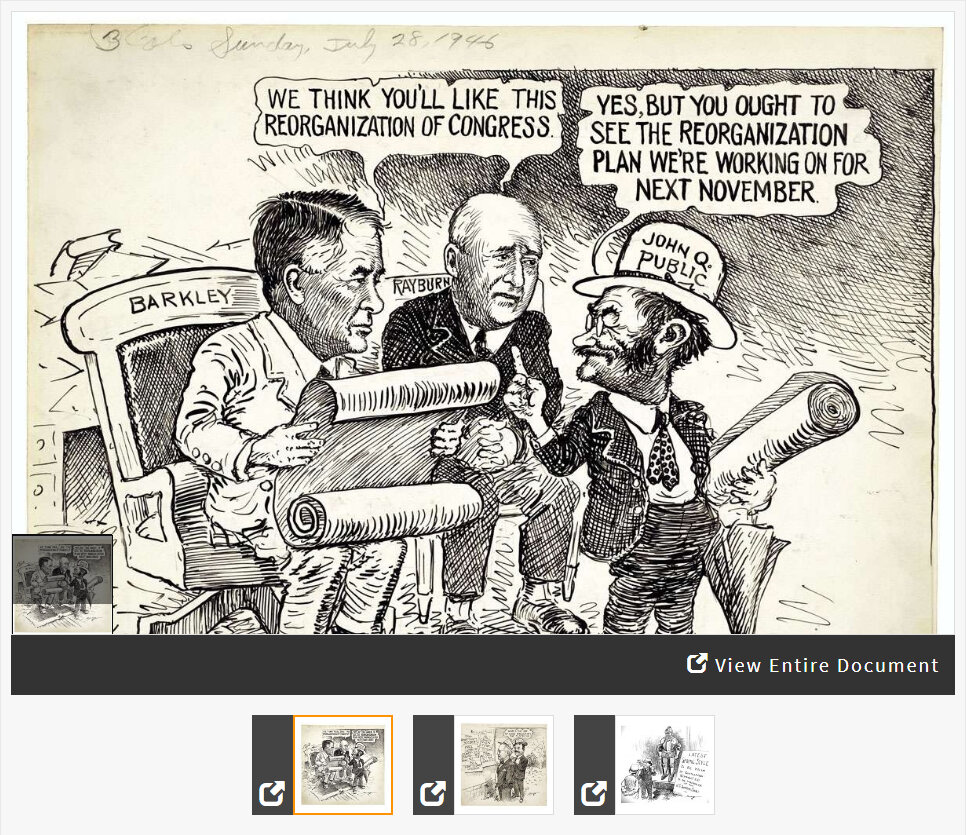Suggested Teaching Instructions
Students will discover how the Constitution outlines the process by which Members of Congress, the President, and Supreme Court justices assume office by analyzing three different political cartoons. Use this activity when teaching elections and/or the branches of government.
This activity can be presented to the entire class or completed by students individually or in groups. For grades 6–12. Approximate time is 30–45 minutes.
Ask students to examine each of the three cartoons. They should start by identifying the people, objects, and places in each cartoon. Students should also pay careful attention to the text. After students have carefully studied each cartoon, they should answer the following discussion questions:
- Are any of the visuals in the cartoon symbols? If so, what do you think they stand for?
In the first cartoon, "John Q. Public" is a generic name in the United States to denote a symbolic member of society deemed a "common man." He has no strong political or social biases and represents the randomly selected "man on the street." In the third cartoon, the suit of armor represents the intense review process of individuals appointed to the Supreme Court.
- Which branch of government is represented in each cartoon?
Cartoon #1: The Legislative Branch
Cartoon #2: The Executive Branch, specifically the President
Cartoon #3: The Judicial Branch, specifically the Supreme Court
Ask students to summarize what they think each cartoon is about in their own words. Ask if there is any missing information that they need to fully understand the cartoon. After students complete their initial analysis, they can click "View Entire Document" to view the historical context for the cartoon and information on the historical figures depicted in each cartoon.
Next, ask students to consider how the artist, Clifford Berryman, represents the process by which Members of Congress, the President, and Supreme Court Justices take office? (Who decides who gets to be a Member of Congress, the President, and a Supreme Court Justice?)
The following links to corresponding sections of the Constitution are provided for reference, or students can use their own copies of the Constitution.
Finally, students should conclude the activity by clicking "When You're Done" and answering the following:
1. Based on your observations of each political cartoon and your reading of the Constitution, what are the differences between how Members of Congress, the President, and the Supreme Court Justices take office?
Answers may include:
Members of the House of Representatives and the Senate are elected by the people of each state. As seen in the first political cartoon, the people (represented by John Q. Public) directly determine the makeup of Congress.
People also vote for President, but a vote for a presidential candidate is actually a vote for the candidate's electors in each state/District of Columbia. In order to become president, a candidate must earn the majority number of electoral votes. (Today this is 270.) This is why in the political cartoon, we see two candidates reviewing polls about the predicted number of electoral votes and states that each candidate will win.
Supreme Court Justices are different in that they are not elected, but rather nominated by the President and approved by two-thirds of the Senate. The political cartoon references the Senate confirmation process by suggesting a suit of armor is necessary to face the Senate's approval process.
2. According to the United States Constitution, which branch is the only branch of government that is directly elected by the people?
The Legislative Branch3. How are citizens' voices reflected in the presidential election and appointment of Supreme Court Justices?
While American voters do not directly elect the President, their votes still matter in in determining which candidate receives each state's electoral votes. There is no election for members of the Supreme Court, however Americans can still indirectly influence who is appointed to the Supreme Court through presidential and Senate elections.
Additional Background Information and Political Cartoon ResourcesThese cartoon was drawn by Clifford Berryman, one of Washington, DC's best-known cartoonists in the early to mid-1900s. Berryman drew for the
Washington Post and
Evening Star newspapers. His cartoons touched on a variety of subjects including politics, elections, and both World Wars. A collection of 2,400 original pen-and-ink drawings by Clifford K. Berryman from the U.S. Senate Collection is housed at the Center for Legislative Archives at the National Archives. The Center has created a variety of
resources which feature the cartoons including eBooks, exhibits, lesson plans, and more.
You may also find it helpful to share document analysis worksheets for analyzing political cartoons with your students. 




